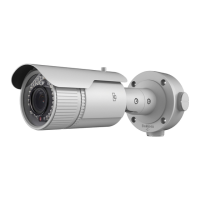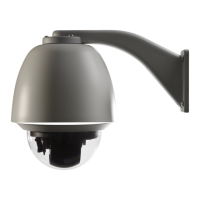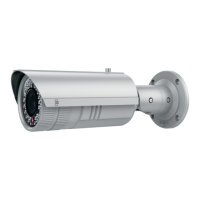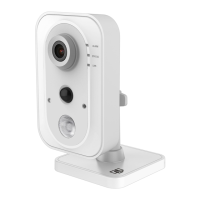Do you have a question about the Interlogix TVB-5302 and is the answer not in the manual?
Configure browser settings for camera access and ActiveX controls.
Steps to enable ActiveX controls in Internet Explorer for camera interaction.
Procedure for setting an admin password via a web browser.
Procedure for activating the camera using device management software.
Explanation of the main configuration folders and their purpose.
Settings related to protocol type, live view performance, and local storage paths.
How to configure the camera's date and time settings using NTP or manual sync.
Configure IP address, subnet mask, gateway, DNS, and other network settings.
Set up HTTP, RTSP, HTTPS, and Server ports for camera access.
Configure Dynamic DNS service for remote access.
Configure PPPoE settings for establishing a network connection.
Configure Simple Network Management Protocol settings for monitoring.
Configure network access control using IEEE 802.1X authentication.
Configure Quality of Service settings to manage network traffic priority.
Configure FTP settings for uploading snapshots and recorded files.
Configure Universal Plug and Play for easier network device discovery.
Configure email settings for sending alerts and notifications.
Configure Network Address Translation (NAT) for port mapping.
Configure HTTPS for secure web access and certificate management.
Adjust stream type, resolution, bit rate, frame rate, and video encoding.
Define Region of Interest for prioritized video processing and quality.
Enable video analytics for generating VCA alarms and metadata.
Configure automatic or scheduled switching between day and night camera modes.
Adjust brightness, contrast, saturation, and sharpness for optimal image quality.
Configure iris mode, exposure time, and gain for image brightness control.
Configure on-screen display of camera name, date, and time.
Add custom text lines to the live video stream for display.
Create privacy masks to conceal sensitive areas in the video feed.
Configure basic motion detection with area and sensitivity settings.
Configure advanced motion detection features, including schedules and linkage.
Set up alarms for when the camera lens is covered or obstructed.
Configure notifications for irregular events like HDD full or network disconnection.
Configure external alarm inputs and their arming schedules and linkage.
Configure external alarm outputs, delay times, and arming schedules.
Configure line crossing detection for people, vehicles, or objects.
Set up an area for intrusion detection and configure alarm actions.
Configure continuous snapshots at scheduled intervals.
Configure snapshots triggered by events like motion detection or alarms.
Configure network storage system (NAS) for remote recording storage.
Manage and format storage devices like HDDs and SD cards.
Add, delete, and manage user accounts, permissions, and passwords.
Overview of user roles (Admin, Operator, Viewer) and their privileges.
Step-by-step guide to creating and removing user accounts.
Instructions for removing existing user accounts.
How to change user details like password and permissions.
Secure the live view stream data using RTSP authentication.
Implement access control by filtering IP addresses for camera access.
Configure security services like illegal login lock and SSH access.
Reset camera parameters to factory default settings.
Save and load camera configuration settings for backup or transfer.
Update the camera's firmware to the latest version.
Remotely restart the camera through the web browser interface.
Procedures for logging into and out of the camera's web interface.
Accessing and using the live video feed from the camera.
Searching and viewing recorded video footage from storage.
Viewing and searching system event logs for troubleshooting.
Interface for controlling camera pan, tilt, zoom, and other functions.
Save specific camera positions as presets for quick recall.
Recall saved camera positions using presets.
Configure sequences of preset movements for automated camera panning.
Define parameters for preset tours, including dwell time and speed.
Activate a configured preset tour sequence.
Configure browser settings for camera access and ActiveX controls.
Steps to enable ActiveX controls in Internet Explorer for camera interaction.
Procedure for setting an admin password via a web browser.
Procedure for activating the camera using device management software.
Explanation of the main configuration folders and their purpose.
Settings related to protocol type, live view performance, and local storage paths.
How to configure the camera's date and time settings using NTP or manual sync.
Configure IP address, subnet mask, gateway, DNS, and other network settings.
Set up HTTP, RTSP, HTTPS, and Server ports for camera access.
Configure Dynamic DNS service for remote access.
Configure PPPoE settings for establishing a network connection.
Configure Simple Network Management Protocol settings for monitoring.
Configure network access control using IEEE 802.1X authentication.
Configure Quality of Service settings to manage network traffic priority.
Configure FTP settings for uploading snapshots and recorded files.
Configure Universal Plug and Play for easier network device discovery.
Configure email settings for sending alerts and notifications.
Configure Network Address Translation (NAT) for port mapping.
Configure HTTPS for secure web access and certificate management.
Adjust stream type, resolution, bit rate, frame rate, and video encoding.
Define Region of Interest for prioritized video processing and quality.
Enable video analytics for generating VCA alarms and metadata.
Configure automatic or scheduled switching between day and night camera modes.
Adjust brightness, contrast, saturation, and sharpness for optimal image quality.
Configure iris mode, exposure time, and gain for image brightness control.
Configure on-screen display of camera name, date, and time.
Add custom text lines to the live video stream for display.
Create privacy masks to conceal sensitive areas in the video feed.
Configure basic motion detection with area and sensitivity settings.
Configure advanced motion detection features, including schedules and linkage.
Set up alarms for when the camera lens is covered or obstructed.
Configure notifications for irregular events like HDD full or network disconnection.
Configure external alarm inputs and their arming schedules and linkage.
Configure external alarm outputs, delay times, and arming schedules.
Configure line crossing detection for people, vehicles, or objects.
Set up an area for intrusion detection and configure alarm actions.
Configure continuous snapshots at scheduled intervals.
Configure snapshots triggered by events like motion detection or alarms.
Configure network storage system (NAS) for remote recording storage.
Manage and format storage devices like HDDs and SD cards.
Add, delete, and manage user accounts, permissions, and passwords.
Overview of user roles (Admin, Operator, Viewer) and their privileges.
Step-by-step guide to creating and removing user accounts.
Instructions for removing existing user accounts.
How to change user details like password and permissions.
Secure the live view stream data using RTSP authentication.
Implement access control by filtering IP addresses for camera access.
Configure security services like illegal login lock and SSH access.
Reset camera parameters to factory default settings.
Save and load camera configuration settings for backup or transfer.
Update the camera's firmware to the latest version.
Remotely restart the camera through the web browser interface.
Procedures for logging into and out of the camera's web interface.
Accessing and using the live video feed from the camera.
Searching and viewing recorded video footage from storage.
Viewing and searching system event logs for troubleshooting.
Interface for controlling camera pan, tilt, zoom, and other functions.
Save specific camera positions as presets for quick recall.
Recall saved camera positions using presets.
Configure sequences of preset movements for automated camera panning.
Define parameters for preset tours, including dwell time and speed.
Activate a configured preset tour sequence.
| Brand | Interlogix |
|---|---|
| Model | TVB-5302 |
| Category | IP Camera |
| Language | English |











